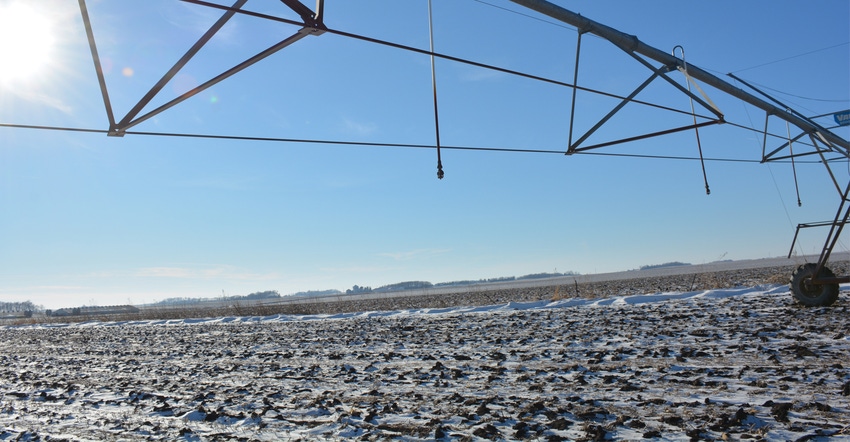
Coming off widespread drought in many areas throughout 2021, farmers are hoping for replenished soil moisture. But just in case Mother Nature doesn’t come through, farmers need to ensure their irrigation systems will be in working order when and if they are needed for 2022.
A lot of center pivots put in overtime last season, so systems may have more wear and tear than in a “normal year.” With that in mind, the first step for getting off to a good start with your irrigation season may be to remember where last year left off.
“Review your list from the previous year of what needs to be fixed on each system,” suggests Steve Melvin, a Nebraska Extension irrigated cropping systems educator based in Central City, Neb. “Make sure you have the parts on hand, or talk to your dealer if you’re going to have an inspection scheduled early and get it done.”
He says many pivot companies offer winter service programs that farmers may wish to use, unless they want to make repairs themselves.
Melvin suggests scheduling a preseason system tuneup well in advance. With the current supply chain issues, he says a call for parts should be placed early in case replacement parts are hard to come by.
Once a farmer addresses the necessary repairs noted from last year, Melvin suggests that they turn to the operator’s manual, which contains a preseason checklist for their specific pivot system. “Sometimes guys forget about that,” he says. “Each pivot can be a little bit different, so that’s always the place to start.”
Some of those things that should be checked and included from the operator’s manuals are grease zerks, as well as draining any water out of the gearboxes and making sure they’re full of oil.
Melvin also suggests adjusting the unit’s tires to the air pressure recommended in the operator’s manual after the temperature warms up in the spring. Keep in mind, higher pressure will make the tire very hard and will result in deeper tire tracks over the summer.
Melvin suggests simply giving the irrigation unit a thorough once-over. “Just give the machine a good look over, and make sure there are no missing bolts or there’s nothing cracked, bent or broken,” he says. “Storm damage on pivots can be less obvious than an overturned system. Make sure the U-joints on the drive shafts are tight and looking good.”
Sprinkler pattern important
Another set of documentation a farmer should have received with their irrigation unit is the “sprinkler chart.” Melvin says farmers should revisit this document for the specifics of each unit because every system has a unique design to match the field it is on and the well capacity.
“Pivots can have lots of options, including different types of sprinklers and how long the drops are, the sprinkler spacing, and all of those things can be unique,” he says. “The sprinkler chart also can give you the correct operating pressure for the system, the correct flow of water into the system, and so on.”
He stresses the importance of farmers inspecting the sprinkler package and checking the operating pressure each year as variables can change the system’s performance from one year to the next.
Changes in the water table can affect the system’s performance, as can leaks and broken sprinklers. Melvin stresses the importance of monitoring pressure throughout the irrigation season, and the sprinkler chart is “the best place for you to find the correct operating pressure for your machine. Pressure is one of the most critical things from my perspective that you need to take a look at. If the pressure is too high, you’re going to spend more money on energy than you need to. And if the pressure is too low, you’re going to have a non-uniform application of water across your field.”
Melvin adds, “In the second scenario, what you end up doing is overwatering part of the field, so you can fully water the areas that are getting less water because of the low pressure.”
Don’t overlook regulators
With an eye on pressure, Melvin says an often overlooked device is the pressure regulator. “Pressure regulators that are not working anymore are very hard to see visually,” he says. “The industry recommends that about every 10 years or 10,000 hours of operation, the sprinkler package including the pressure regulators should be replaced. This recommendation, at the minimum, means that you need to start inspecting the pressure regulators and sprinklers after they get that old and make sure they’re working correctly and see if they need to be replaced.”
If the pivot just quits moving, Melvin says that farmers know to diagnose and fix the problem, but when the sprinkler package starts failing, the water application deteriorates.
“And that creates non-uniformity problems, which usually results in needing to pump more water to offset the non-uniformity,” he says. Knowing that many systems across the landscape are aging, Melvin says many have the original sprinkler package, and regulator failure is “probably the most common problem that you see on 10-year-old and older pivots.”
Lastly, Melvin recommends giving the pivot system a test drive before the growing season, suggesting timing the test run early in the morning or later in evening using the gleam of the sun’s rays to see the spray pattern.
“It should be a nice uniform pattern with less water toward the center point, and more water toward the outer end of the pivot,” he says. “You can just tell a lot by just taking some time to go out and look at it.”
Melvin recommends looking at the spray pattern every couple of weeks during the irrigation season to make sure all is working as desired. To learn more, email Melvin at [email protected].
About the Author(s)
You May Also Like






